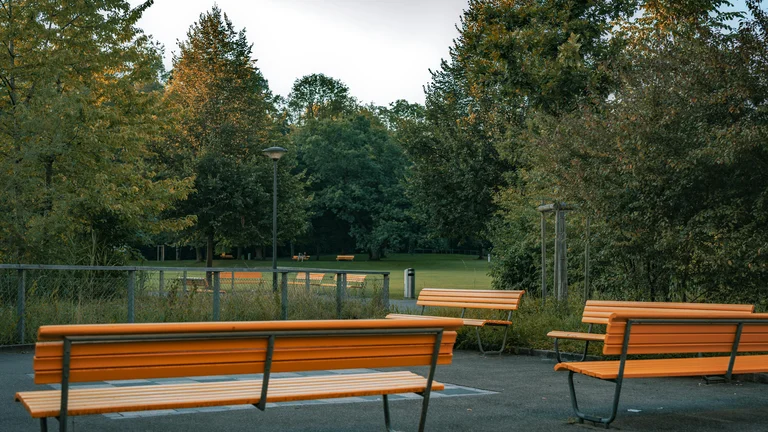The Enduring Power of Park Bench Confession Scenes in Visual Narratives

Iconic park bench confession scenes remain some of the most emotionally resonant moments in cinema and television. These scenes leverage the simple surrounding of a park bench as a versatile storytelling device, allowing characters to reveal their deepest thoughts, confess love, admit guilt, or confront emotional truths. Their popularity stems from the natural setting, the intimate seating arrangement, and the palpable vulnerability these moments foster. Unlike high-drama confrontations set amid chaos or grandeur, a park bench scene grounds the narrative in quiet realism, offering viewers a sense of solitude amid the bustle—a momentary pause where raw honesty unfolds.
Throughout cinematic history, park bench confessions have been crafted to evoke empathy, tension, and catharsis simultaneously. The bench itself becomes a silent witness to emotional transformations, grounding characters in a shared human experience. This setting strips distractions and focuses attention entirely on dialogue, body language, and unspoken implications. The confined yet open space forces characters into proximity, intensifying emotional exchanges. One can often observe how lighting, camera angles, and ambient noise play pivotal roles in enhancing the emotional stakes during these scenes, making a simple park setting a dramatic stage.
Several factors contribute to the effectiveness of these park bench scenes. The physical seating aligns characters side by side or face to face, influencing their interpersonal dynamics. For example, characters sitting shoulder-to-shoulder might indicate support or camaraderie, while facing one another signals confrontation or vulnerability. This spatial orientation subtly guides audience perception of the emotional chemistry at play. Moreover, the outdoor environment allows background elements—falling leaves, distant children playing, or passing strangers—to underscore themes of time passing, innocence lost, or the world's indifference to personal turmoil. The universality of parks as accessible public domains enhances relatability, as nearly everyone can recall a moment of quiet reflection or meaningful conversation in such a setting.
Historical Context and Evolution of Park Bench Confession Scenes
The tradition of unfolding pivotal emotional revelations on park benches dates back decades, reflecting shifts in narrative priorities and social norms. Early Hollywood often used benches as neutral grounds where characters escaped from formal, controlled environments into more authentic emotional spaces. Films of the 1940s and 1950s utilized park benches as settings for romantic exchanges, confessions of hidden love, or life-altering decisions. These scenes maintained a decorum aligned with the era's sensibilities—words were chosen carefully, emotions were hinted at more than overtly expressed, and visual restraint highlighted internal conflict.
As storytelling evolved, particularly during the New Hollywood era and into contemporary cinema, park bench confession scenes grew more explicit and raw. The influence of method acting and realism introduced more naturalistic dialogue and body language, breaking away from staged deliveries toward nuanced, spontaneous performances. Filmmakers became increasingly interested in peeling back characters’ façades in these intimate moments, syncing visual storytelling with evolving societal openness about emotional and psychological struggles.
Entering the television realm, park bench scenes took on further significance. The serialized structure allowed these moments to deepen character development over time, creating anticipation and repeated returns to the park bench as a thematic motif. Iconic shows utilized these scenes not just to confess romantic feelings but also to address trauma, regret, and reconciliation. Their effectiveness grew as directors employed subtle props and symbolism—seasonal changes, worn benches, and environmental sounds—to mirror emotional tone and progression.
Analyzing Iconic Park Bench Confession Scenes Across Genres
Park bench confession scenes transcend genre boundaries, appearing in romantic dramas, thrillers, sitcoms, and even supernatural stories. Each genre adapts this simple setup to serve its unique narrative goals while maintaining core elements of emotional transparency and relational intimacy.
In romantic dramas, park bench confessions are frequently turning points where unspoken feelings transform into declarations of love, breakdowns, or decisions to part. The park bench becomes neutral territory where vulnerability is safely shared. The quiet, natural setting helps lower defenses, enabling characters to confront their true feelings without external judgment. Typically, dialogue balances hope, longing, and apprehension, creating tension between possibility and risk.
Thrillers or crime dramas often use park bench scenes differently, emphasizing confession as a dramatic revelation of guilt, secrets, or betrayal. The serenity of the park contrasts with the intensity of the revelation, heightening suspense through juxtaposition. Characters might confess involvement in crime, disclose critical evidence, or reveal double identities, using the public space to underscore danger or urgency masked by calm. The setting’s openness paradoxically enhances the claustrophobic emotional experience.
In comedies and sitcoms, park bench confession scenes offer opportunities for humor blended with genuine sentiment. The bench becomes a place for awkward admissions, embarrassing truths, or ironic revelations. Writers leverage the informality of the location to invoke lightheartedness while grounding humor in relatable human foibles. These moments often strike a balance between comedy and sincerity, underscoring character growth through laughter and self-awareness.
Supernatural or fantasy genres adapt park bench confession scenes to incorporate otherworldly elements. Characters might reveal mystical knowledge, hidden identities, or existential dilemmas while seated on an ordinary bench in an otherwise enchanted or surreal setting. The contrast between the mundane bench and extraordinary revelations underscores the narrative’s blend of reality and fantasy. These scenes often employ ambient cues—ethereal lighting, distant whispers, or altered perspectives—to heighten emotional stakes.
Technical and Cinematic Techniques Elevating Park Bench Confession Scenes
While the physical setting of a park bench provides the foundational space for confession scenes, the execution relies heavily on cinematic craft to convey emotional nuance. Directors, cinematographers, and actors collaborate to transform a simple bench into a powerful storytelling device through a range of techniques.
Camera Work: The choice of shots and angles contributes significantly to the scene's tone and intimacy. Close-ups on the confessor’s face highlight vulnerability and emotional shifts. Conversely, wide shots that isolate characters on an expansive bench emphasize loneliness or separation. Slow zoom-ins or dolly shots often build tension gradually, drawing viewers closer as the confession unfolds.
Lighting: Naturalistic lighting tends to dominate these scenes, reinforcing authenticity. Overcast days or late afternoon sunlight evoke contemplative moods, while deliberately contrasting shadows can symbolize internal conflict or duality. Filmmakers sometimes employ backlighting to silhouette characters, heightening mystery or distance during particularly painful confessions.
Sound Design: Ambient sounds in a park—rustling leaves, distant traffic, birdsong—serve as subtle emotional undertones. The deliberate use of silence or muffled background noise can intensify focus on dialogue and breath sounds. Occasional external interruptions (a dog barking, a passerby) introduce realism and unpredictability, sometimes framing comedic or dramatic beats.
Performance and Dialogue: Actors often rely on nuanced facial expressions, hesitations, and subtle physical gestures to communicate unspoken tensions. The script must balance exposition with subtext; meaning often lies in what is left unsaid or implied through inflection and timing. Confessions in these scenes generally eschew theatricality in favor of restraint, promoting a sense of real-life interaction.
Combining these elements strategically, filmmakers craft moments where viewers feel they are eavesdropping on intimate truths, enhancing empathy and emotional investment. Each technical choice amplifies the themes of vulnerability, connection, and transformation that park bench confession scenes embody.
Notable Examples of Iconic Park Bench Confession Scenes in Film and Television
Several park bench confession scenes have become cultural touchstones due to their emotional resonance, performances, and narrative impact. Analyzing a few of these examples reveals common threads and unique approaches shaping this storytelling tradition.
Forrest Gump (1994): One of the most enduring references is Forrest Gump sitting on a park bench sharing his life story. While not a confession in the romantic sense, this extended monologue blurs the lines between confession and narration. The park bench here symbolizes a vantage point of reflection and openness, inviting listeners to witness a life marked by innocence and perseverance. The scene’s relaxed pace, sincere tone, and simple framing make it universally accessible and empathetic.
When Harry Met Sally... (1989): This film features multiple crucial scenes on park benches, culminating in Harry’s confession of love. The bench setting grounds their emotionally charged conversation, contrasting bustling city life with the intimacy of their exchange. The dialogue-driven scene uses timing, pauses, and vulnerability to capture the complexity of friendship transforming into romantic love. The bench here serves as a neutral ground where honesty triumphs over fear.
Dead Poets Society (1989): The park bench is the site of emotional confrontations and confessions among students and teachers. In a key scene, characters reveal fears and hopes surrounding conformity and self-expression. The natural environment, paired with the bench, supports themes of freedom and rebellion versus societal constraints. The subtle physical closeness and shared seating suggest solidarity amid adversity.
Gilmore Girls (2000–2007): Numerous confession scenes between Lorelai and Rory unfold on town park benches. These moments encapsulate mother-daughter honesty, confessions of insecurity, and affirmations of unconditional support. The recurring use of the bench motif reinforces themes of grounding amid life’s uncertainties. The dialogue's rapid-fire nature contrasts with the physical stillness, making these scenes emotionally layered and authentic.
The Notebook (2004): Another memorable park bench confession scene involves Noah and Allie reconnecting and acknowledging their enduring love. The bench represents a shared past and hope for future reconciliation. Visual elements—the autumn leaves, gentle rain, and dimming light—amplify the bittersweet tone, making the bench scene a cinematic symbol of enduring passion against odds.
How Setting Influences Emotional Intensity in Park Bench Confessions
The physical environment surrounding a park bench dramatically shapes the emotional weight of confession scenes. Parks are symbolic of both public exposure and natural refuge, creating tension between openness and privacy. Variations in time, weather, and surrounding activity further modulate tonal undercurrents.
Seasonal Effects: Different seasons symbolize thematic nuances. Spring often denotes new beginnings or hope, while autumn evokes nostalgia and change. Winter scenes might emphasize isolation or hardship, using barren trees and muted color palettes to mirror internal desolation. Summer settings can contrast heat and swelling emotions with moments of calm.
Time of Day: Daytime bench scenes communicate clarity, exposure, and sometimes awkwardness or vulnerability in the open. Conversely, dusk or nighttime scenes benefit from shadows and artificial lighting, fostering intimacy and secrecy. Each adjustment guides viewers’ subconscious reading of the character interactions.
Park Activity and Atmosphere: Crowded parks create a paradoxical backdrop—confessions occur amid distractions, highlighting characters’ willingness to risk social exposure. Empty parks deepen intimacy but possibly evoke loneliness or danger. Background elements like children playing or joggers passing by can symbolize normalcy continuing beyond personal upheavals.
The relationship between setting and emotion in park bench scenes demands meticulous planning. Directors often scout multiple locations to find benches that visually align with the desired mood—benches by water, shaded by trees, or bordering busy paths offer differing emotional palettes. Props and set dressing may subtly adjust the scene without losing naturalism, adding depth to the storytelling.
Psychological Perspectives on Confessions and Relational Dynamics on Park Benches
From a psychological viewpoint, park bench confession scenes illuminate fundamental interpersonal dynamics. Confessions represent acts of vulnerability, trust, and risk, all of which are heightened by the physical conditions of seating and setting.
Proxemics and Seating Orientation: The spatial arrangement on a bench impacts perceived intimacy. Sitting close often indicates trust and emotional openness, while physical distance suggests guardedness or conflict. Angling bodies toward each other facilitates connection; facing away can signal avoidance or disapproval. These nonverbal cues complement the verbal confession's impact and reflect unspoken emotional states.
Environmental Psychology: Natural settings reduce stress and promote openness, making parks ideal for emotional conversations. Biophilic effects—humans’ innate affinity for nature—enhance comfort levels and decrease defensive behavior. This helps explain why park benches are recurrent choices for scenes requiring difficult disclosures.
Confession as Relational Repair: Psychologically, confessions often aim to restore or redefine relationships. Whether admitting fault, expressing love, or revealing secrets, these moments involve negotiation of trust and power. The bench scene’s static nature metaphorically reflects the momentary suspension of action to process emotional complexity. The audience witnesses a form of relational recalibration triggered by the confession.
Integrating psychological theory with cinematic presentation enriches understanding of why park bench confession scenes resonate so strongly. They present tangible manifestations of abstract emotional dynamics, making internal conflict externally visible and socially meaningful.
Step-by-Step Guide to Crafting an Effective Park Bench Confession Scene in Screenwriting
Writing a compelling park bench confession scene requires attention to detail in dialogue, setting, character psychology, and pacing. Below is a detailed breakdown of practical steps for screenwriters aiming to integrate such scenes effectively:
- Establish Context: Define the narrative moment preceding the confession. Consider how prior events build emotional tension necessitating a revealing conversation.
- Select Setting: Choose a park bench that visually supports the mood—near water for calm, under stark trees for tension, or in urban parks for realism.
- Determine Characters’ Relationship: Decide how closeness or conflict manifests physically and verbally. Craft seating arrangements that reflect relational dynamics.
- Write Natural Dialogue: Prioritize authenticity over exposition. Use pauses, incomplete sentences, and hesitations to mirror real speech patterns.
- Incorporate Subtext: Embed underlying emotions and intentions beneath spoken words. Use metaphors, tone shifts, and body language cues.
- Add Environmental Details: Use background sounds, weather, and lighting to enhance emotional atmosphere.
- Control Pacing: Adjust rhythm to match confession intensity—draw out moments of hesitation, accelerate during climactic admissions.
- End with Resonance: Conclude the scene with a silence, gesture, or symbolic action reinforcing the confession’s impact.
Following these steps helps develop scenes that feel lived-in, emotionally rich, and dramatically effective. Collaborating with actors and directors further refines delivery and staging for maximum audience engagement.
Comparative Table: Emotional Themes and Technical Elements in Famous Park Bench Confession Scenes
| Film/Show | Emotional Theme | Setting Description | Dominant Technique | Character Dynamic |
|---|---|---|---|---|
| Forrest Gump | Life reflection; innocence | Sunny park bench with gentle passersby | Monologue, close-ups | Storyteller and listener |
| When Harry Met Sally... | Romantic confession | City park under autumn leaves | Dialogue-driven, medium shots | Friends to lovers |
| Dead Poets Society | Rebellion; identity | Quiet park bench amid trees | Symbolic lighting, group interaction | Teacher and students |
| Gilmore Girls | Family honesty | Small town park benches | Rapid-fire dialogue, close proximity | Mother and daughter |
| The Notebook | Enduring love | Rainy park bench in autumn | Atmospheric effects, close-ups | Estranged lovers |
Key Elements to Consider When Analyzing or Creating Park Bench Confession Scenes
When evaluating existing scenes or developing new ones, it helps to keep in mind several critical aspects that consistently shape the effectiveness of park bench confessions. The following list highlights what to prioritize:
- Authenticity: Does the dialogue and behavior feel genuine and relatable?
- Emotional Clarity: Are the characters’ emotions clearly conveyed through words and actions?
- Setting Integration: How well does the physical environment support the scene’s mood?
- Character Interaction: Is the seating and body language reflecting the relational state?
- Pacing and Timing: Are pauses, silences, or interruptions used purposefully?
- Technical Cohesion: Do lighting, sound, and camera work combine to enhance emotional impact?
- Subtextual Depth: Is there a layer of meaning beneath what is explicitly stated?
Addressing these points enhances both the appreciation and creation of emotionally compelling park bench confessions, making scenes not only memorable but deeply impactful in the broader narrative.
Expanding the Reach: Real-World Applications and Cultural Impact of Park Bench Confession Scenes
Beyond fictional narratives, park bench confession scenes influence real-world social and cultural perceptions of vulnerability and communication. Media depictions inspire audiences to value honesty and openness in their interpersonal relationships. The symbolism of benches as safe spaces for emotional exchange resonates with many people’s lived experiences, encouraging reflection on how physical environments affect emotional disclosure.
Psychologists and therapists sometimes reference such scenes to illustrate the importance of setting in facilitating difficult conversations. In counseling, seating arrangements and environments are adjusted to optimize openness and empathy, a principle echoed in the cinematic choices surrounding park bench confessions. Public parks have occasionally become informal social spaces where individuals meet for confessions of feelings, reconciliation, or personal revelations, mirroring the narrative trope.
Culturally, these scenes enrich collective memory by representing common moments of human vulnerability. They offer models for expressing complex emotions with courage and grace. The consistency with which park bench confessions appear across media testifies to their enduring appeal and utility as narrative tools for exploring relationships.
A modern impact includes adaptations in digital storytelling. Web series, podcasts, and virtual reality narratives recycle and reinterpret the bench motif to suit new formats, preserving its emotional potency while innovating presentation. Social media also amplifies iconic bench confessions through memes, video essays, and fan discussions, contributing to their status as cultural landmarks.
FAQ - Iconic Park Bench Confession Scenes
Why are park bench confession scenes so effective in storytelling?
Park bench confession scenes are effective because they use a simple, relatable setting that encourages intimacy and vulnerability. The bench's physical arrangement fosters close proximity, making emotional exchanges feel natural and authentic. The outdoor environment adds layers of symbolism around openness and reflection, enhancing the scene's emotional impact.
How have park bench confession scenes evolved over time?
Initially restrained and formal, park bench confession scenes have evolved into more naturalistic and explicit portrayals of emotions. Shifts in acting styles, social openness, and storytelling goals led to dialogue and performances that emphasize realism and psychological depth, reflecting changing cultural attitudes toward emotional expression.
What cinematic techniques are commonly used in these scenes?
Common techniques include close-up shots to highlight vulnerability, natural lighting to evoke realism, ambient sound design to create mood, and careful staging of actors’ seating and body language to communicate relational dynamics. These elements combine to deepen viewers’ emotional engagement.
Can park bench confession scenes appear in genres other than romance?
Yes, park bench confessions appear across genres including thrillers, dramas, comedies, and supernatural stories. While romantic confessions are common, these scenes also serve to reveal secrets, express humor, or confront existential dilemmas, adapted to fit genre-specific emotional tones.
How does the setting of the park bench influence the scene's emotional tone?
Factors such as time of day, season, weather, and park activity alter the emotional tone. For example, autumn leaves can evoke nostalgia, dusk adds intimacy, and crowded parks introduce tension through public exposure. These environmental details underscore and complement the confession’s emotional content.
What psychological factors make park bench confessions relatable to audiences?
Psychologically, these scenes reflect universal experiences of vulnerability, trust, and relational repair. The natural setting reduces stress, encouraging openness, while the spatial proximity mirrors real-world dynamics of closeness and guardedness, making these moments deeply resonant.
How can writers craft authentic park bench confession scenes?
Writers should focus on authentic dialogue, believable character motivations, meaningful subtext, and an environment that supports the emotional tone. Attention to pacing, physical interactions, and background details helps make the confession feel grounded and compelling.
What real-world impact have park bench confession scenes had beyond media?
These scenes have influenced cultural understandings of emotional openness and communication, inspired therapeutic settings’ emphasis on environment, and become symbolic references in public discourse about vulnerability and honesty, reinforcing the bench as a metaphor for safe expression.
Park bench confession scenes serve as powerful narrative devices by combining intimate physical settings with emotional vulnerability. Their simplicity and relatability allow characters to express deep truths across genres, enhanced by cinematic techniques that amplify realism and connection. This enduring motif underscores human experiences of trust, love, and reconciliation.
Iconic park bench confession scenes continue to captivate audiences with their blend of simplicity and emotional complexity. Rooted in relatable settings and enhanced through nuanced cinematic techniques, these moments reveal core human truths about vulnerability, connection, and transformation. Their adaptability across genres and media testifies to their lasting narrative power, offering profound insights into how environment and interaction shape emotional expression. Understanding the layers embedded within these scenes enriches appreciation both as viewers and creators, highlighting the enduring appeal of a quiet bench as a stage for life’s most revealing conversations.






